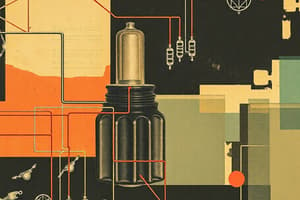Podcast
Questions and Answers
What is the total equivalent resistance of six 10 Ω resistors connected in series?
What is the total equivalent resistance of six 10 Ω resistors connected in series?
- 10 Ω
- 90 Ω
- 30 Ω
- 60 Ω (correct)
In a parallel circuit, if the resistors have the same resistance, how does the total current relate to the individual currents through each resistor?
In a parallel circuit, if the resistors have the same resistance, how does the total current relate to the individual currents through each resistor?
- Total current is equal to the current through the smallest resistor.
- Total current is the same as the supply voltage.
- Total current is the sum of all individual currents. (correct)
- The total current is zero.
What best describes conventional current?
What best describes conventional current?
- The direction in which positive charges would move. (correct)
- The direction in which electrons flow.
- The average current calculated over time.
- The rate at which negative charges move.
What characteristic distinguishes AC current from DC current?
What characteristic distinguishes AC current from DC current?
What is the expression for the total resistance in a parallel circuit with three resistors of equal resistance R?
What is the expression for the total resistance in a parallel circuit with three resistors of equal resistance R?
What is the total resistance in a series circuit with resistors R1 = 5Ω, R2 = 10Ω, and R3 = 15Ω?
What is the total resistance in a series circuit with resistors R1 = 5Ω, R2 = 10Ω, and R3 = 15Ω?
How does Ohm's Law relate to AC circuits compared to DC circuits?
How does Ohm's Law relate to AC circuits compared to DC circuits?
Which statement is true about the current in a series circuit?
Which statement is true about the current in a series circuit?
In DC circuits, what is the relationship defined by Ohm's Law?
In DC circuits, what is the relationship defined by Ohm's Law?
What is the role of superconductors in electricity?
What is the role of superconductors in electricity?
What is the primary defining characteristic of a superconductor?
What is the primary defining characteristic of a superconductor?
In a series circuit, how is the total current related to the current through each component?
In a series circuit, how is the total current related to the current through each component?
What does Ohm's Law define in relation to electrical components?
What does Ohm's Law define in relation to electrical components?
What is primarily considered when analyzing electric circuits?
What is primarily considered when analyzing electric circuits?
What is the relationship between voltage and resistance in a DC circuit as described by Ohm's Law?
What is the relationship between voltage and resistance in a DC circuit as described by Ohm's Law?
What can be concluded about the voltage in a parallel circuit?
What can be concluded about the voltage in a parallel circuit?
Which formula correctly calculates the total resistance for resistors in parallel?
Which formula correctly calculates the total resistance for resistors in parallel?
In the context of electron flow, what is true about conventional current?
In the context of electron flow, what is true about conventional current?
How does the total current in a parallel circuit relate to individual currents flowing in each resistor?
How does the total current in a parallel circuit relate to individual currents flowing in each resistor?
Which statement about the current in DC circuits is correct?
Which statement about the current in DC circuits is correct?
Flashcards are hidden until you start studying
Study Notes
Resistor Relationships in Circuits
- Voltage across an individual resistor is defined by Ohm's Law as ( V_R = IR ).
- In parallel circuits, total resistance ( R_T ) is calculated using the formula: [ \frac{1}{R_T} = \frac{1}{R_1} + \frac{1}{R_2} + \frac{1}{R_3} + ... ]
- Current through components in parallel sums to total current: ( I_T = I_1 + I_2 + ... ).
- Voltage across all components in parallel is equal to the supply voltage: ( V_T = V_1 = V_2 = ... ).
Examples of Resistance Calculations
- Equivalent resistance of six 10 Ω resistors in series is: [ R_T = R_1 + R_2 + ... = 60 , \Omega ]
- Equivalent resistance of six 10 Ω resistors in parallel is: [ R_T = \frac{10}{6} \approx 1.7 , \Omega ]
Current and Charge Flow
- "Conventional current" refers to the direction positive charges flow, opposite to electron movement.
- Current is defined mathematically as ( I = \frac{Q}{t} ).
- In AC circuits, current can be expressed as ( i = \frac{dq}{dt} ).
Direct Current (DC) vs. Alternating Current (AC)
- In DC, charge flow and voltage are constant over time.
- In AC, both current and voltage vary sinusoidally, characterized by the equation: [ v = v_0 \sin(2\pi f t ]
- UAE's mains frequency for AC is 50 Hz.
Superconductors
- Superconductors exhibit zero resistance below a critical temperature ( T_C ).
- Applications include magnetic resonance imaging (MRI).
Electric Circuit Components
- Circuits consist of conducting wires, resistors, capacitors, inductors, diodes, and AC/DC voltage sources.
- Voltage ( V ) and current ( I ) are key parameters; uppercase letters signify DC circuits, while lowercase letters denote AC circuits.
Ohm’s Law
- Ohm’s Law states ( V = IR ) in DC, and ( v = iR ) in AC.
- Resistance ( R ) is a constant ratio of voltage to current.
Circuit Symbols
- Circuit components are represented by standardized symbols, including those for DC and AC voltage sources.
Series Circuits
- Resistors connected in series yield a total resistance given by: [ R_T = R_1 + R_2 + ... ]
- Current through all components in a series circuit is equal: ( I_1 = I_2 = ... ).
- Total voltage is the sum of individual voltages: ( V_T = V_1 + V_2 + ... ).
Magnetic Principles
- Bar magnets consist of aligned atoms with a magnetic moment, forming a macroscopic dipole.
- Magnetic materials are categorized based on their response to an external magnetic field:
- Diamagnetic: weak interaction
- Paramagnetic: moderate interaction
- Ferromagnetic: strong interaction
Electromagnetism
- A coil of wire carrying current creates a magnetic field similar to a bar magnet.
- The magnetic field strength ( H ) within a solenoid is proportional to the current ( I ).
- In an AC solenoid, the magnetic field fluctuates according to the sinusoidal current.
Summary of Key Terms
- Understand and define electric charge, electric field, electrostatics law, Ohm's law, series and parallel circuits, electric power, and the relationship between moving charge and magnetic moment.
Superconductors
- Superconductors exhibit zero electrical resistance below their critical temperature (TC).
- Applications include magnetic resonance imaging (MRI) technology.
Electric Circuits
- Composed of conducting wires, circuit elements (resistors, capacitors, inductors, diodes), voltage sources (AC and DC), and current sources.
- Key parameters: voltage (V) across elements and current (I) through elements.
- In DC circuits, the terms are upper-case (V, I); in AC circuits, they are lower-case (v, i).
Ohm’s Law
- Ohm’s Law: V = IR (DC) or v = iR (AC).
- Voltage to current ratio is constant (resistance, R).
- Example: With a DC voltage of 5.0 V and resistance of 10 Ω, current can be calculated as I = V/R = 0.5 A.
Circuit Component Symbols
- Specific symbols represent circuit components, such as DC and AC voltage sources.
Series Circuits
- Components are connected sequentially; total resistance (RT) is the sum of individual resistances: RT = R1 + R2 + ...
- Current is identical through all components (I1 = I2 = ...).
- Total voltage is the sum of individual voltages: VT = V1 + V2 + ...
Parallel Circuits
- Components are connected between two supply wires; total resistance (RT) calculated using the formula 1/RT = 1/R1 + 1/R2 + ...
- Total current is the sum of all branch currents: IT = I1 + I2 + ...
- Voltage across all components is the same: VT = V1 = V2 = ...
Simple Circuit Calculations
- Series Resistor Example: Six 10 Ω resistors in series give RT = 60 Ω.
- Parallel Resistor Example: Six 10 Ω resistors in parallel give RT = 10/6 = 1.67 Ω.
Current and Electron Flow
- Conventional current direction represents the flow of positive charges, opposite to electron movement.
- Rate of charge movement is defined as I = Q/t; for electrons: I = -Qe/t.
- In AC circuits, current is expressed as i = dq/dt.
DC and AC Current
- DC current is constant over time (I = constant), with constant voltage (V).
- AC current varies over time, typically sinusoidal, at a mains frequency of 50 Hz in the UAE.
Electrostatics
- Matter is composed of charged particles (electrons and protons).
- Charge imbalance can occur through contact, friction, or induction.
- Charge on an electron: qe = -1.6 × 10^-19 C; charge on a proton: qp = +1.6 × 10^-19 C.
Electrostatic Laws
- Electric field (E) direction: outwards from positive charges, inwards towards negative charges.
- Coulomb's Law quantifies the force between charges: F = k(Q1Q2)/d² (inverse square law).
Electric Field Distribution
- Electric field distribution is observed in diagrams indicating forces between charged particles.
Electric Potential
- Potential energy arises when charges are positioned in electric fields.
- Voltage (V) is the potential energy per unit charge, measured in volts (1 V = 1 J/C).
- UAE mains voltage is 220 V (AC).
Electrodynamics
- Focuses on electric charges in motion; electric current occurs in conductors.
- Conductors enable easy charge flow, insulators restrict flow, and semiconductors provide controlled charge movement based on conditions.
Electric Power
- Electric power (P) is measured in watts (W); 1 W = 1 J/s.
- Power in DC: PDC = IV.
- Power in AC uses RMS values: PAC = iRMSvRMS.
Electric Power – Example Calculation
- Operating a 100 W light for 5 hours daily over 30 days costs 15 Dhs at the rate of 1 Dhs per kW-hr.
Magnetism
- Magnetic fields arise from moving electric charges, e.g., electrons in atomic orbits.
- The strength of atomic magnetism is defined by the magnetic moment (m).
Moving Charged Particles
- A spinning charged particle produces a magnetic field due to its quantum spin attribute, even neutrons (electrically neutral particles) exhibit this attribute.
Studying That Suits You
Use AI to generate personalized quizzes and flashcards to suit your learning preferences.




